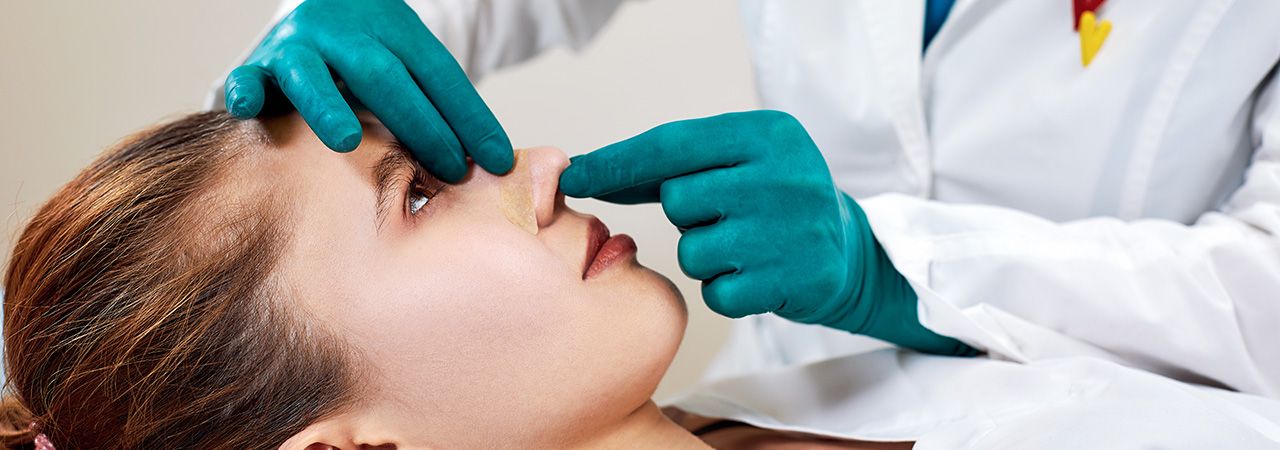Rhinoplasty

Rhinoplasty, also known as nose surgery, makes changes to differentiate the appearance of the nose. This surgery increases or decreases the bridge of the nose, reduces the size or width of the nose, narrows the nostrils, changes the angle between the nose and the upper lip, or reshapes the tip. The surgical techniques used mainly depend on the individualized goals set for each patient. Patients requesting rhinoplasty may describe a functional complaint such as shortness of breath. A curved septum or inferior turbinate are common causes for nasal airway obstruction. Nose surgery can be performed for cosmetic or medical reasons with superior results.
BEST CANDIDATES
There are several reasons why patients may consider rhinoplasty (nose surgery):
- The nose may appear too big or too small
- The nose may not seem to match the rest of the face
- The nose may appear crooked, malformed, or misaligned
- There may be nasal congestion inside the nose, which causes shortness of breath.
- It may be a birth defect, the patient wants it fixed.
ADVICE
During the initial consultation, your doctor first asks about the patient’s specific goals for rhinoplasty; this includes which areas of the patient’s nose they want to improve. These goals can be aesthetic or functional, and both aspects are considered to create a surgical plan. Your doctor will then evaluate the patient and discuss how to individualize the surgical plan. Because each patient’s anatomy and surgical goals are different, your doctor will work with the patient to achieve optimal aesthetic results.
SURGERY INFORMATION
Rhinoplasty is performed under general anesthesia in about 2-3 hours. Your doctor will use an open or closed approach to start nose surgery. He or she will then take different steps based on the patient’s needs. For example, if the primary concern is to remove a nasal hump, a surgical rake or rasp is used to shave off the cartilage. If the tip of the nose is too large, the cartilage breaks down and stitches are used to reshape it.
HEALING AND AFTER SURGERY
Immediately after surgery, your doctor will put dressings inside the nose for best healing, while placing a splint on the outside of the nose to protect the nose and minimize swelling. During the first 48 hours, patients should use a cold compress or hand towel over the surgical area at 20-minute intervals to minimize swelling. Patients should keep their heads elevated and dry throughout their recovery period. One week after the surgery, bruising and swelling are at a level where make-up can hide the remaining bruises in most patients. Patients usually stop taking pain medication after 5-7 days and plan their business plans accordingly. During the recovery period, your doctor will recommend walking at home several times a day to speed healing and minimize the chance of developing blood clots.
OPEN SURGERY?
After numbing the area, your doctor will make incisions to access the bones and cartilage that support the nose. There are two general techniques for making incisions: open and closed (endonasal). Your doctor advocates an open rhinoplasty approach as the nose is fully opened, which better visualizes the nasal structures and provides a more direct route for surgical manipulation. After healing, the small scar on the base of the nose is almost invisible.
CLOSED SURGERY?
The approach used will be made taking into account the requirements of the specific procedure and the patient’s preference and your doctor’s best judgment. The closed or endonasal approach has a more limited dissection of the nasal tissues, but provides excellent visualization of nasal structures and eliminates visible scarring at the base of the nose.
OTHER OPTIONS?
In addition to incision options, there are several methods for strengthening the nose or smoothing surface deformations.
Autologous cartilage grafts from the nasal septum (the wall inside the nose that separates one air passage from another) offer the best chance for a natural result. If cartilage and bone have already been removed from the nasal septum, cartilage from the ear or rib and sometimes bone from the skull are other options.
There are solid silicone implants used in nasal surgery, but they are foreign materials that can become infected or react badly with nasal tissues and must be removed. Natural cartilage is the best option if available.
Fillers or fat grafts can be injected to soften noses, hide deformities or indentations, or add volume to desired areas.
Halaskargazi Mah. Halaskargazi Cd. No:38-66 Lotus Nişantaşı Kat:5 D:92
Şişli/İstanbul/TÜRKİYE
This site has been prepared to provide information about Aesthetic Surgery Operations and Practices. The information on the site can never replace a doctor's consultation. All surgical procedures, information, comments and images described in the content of the site are for informational purposes; Advertising is not intended to guide diagnosis and treatment. This site is protected by copyright laws. Unannounced copying, distribution, modification of the content will initiate legal proceedings. Those who commit copyright infringement are deemed to have accepted legal obligations. The site owner and producers cannot be held responsible for medical or legal problems that may arise due to misunderstanding or use of the information on the site.
© Op.Dr.Ergin YÜCEL. All rights reserved.
Web Tasarım BursaWeb.
© Op.Dr.Ergin YÜCEL. All rights reserved.
Web Tasarım BursaWeb.

